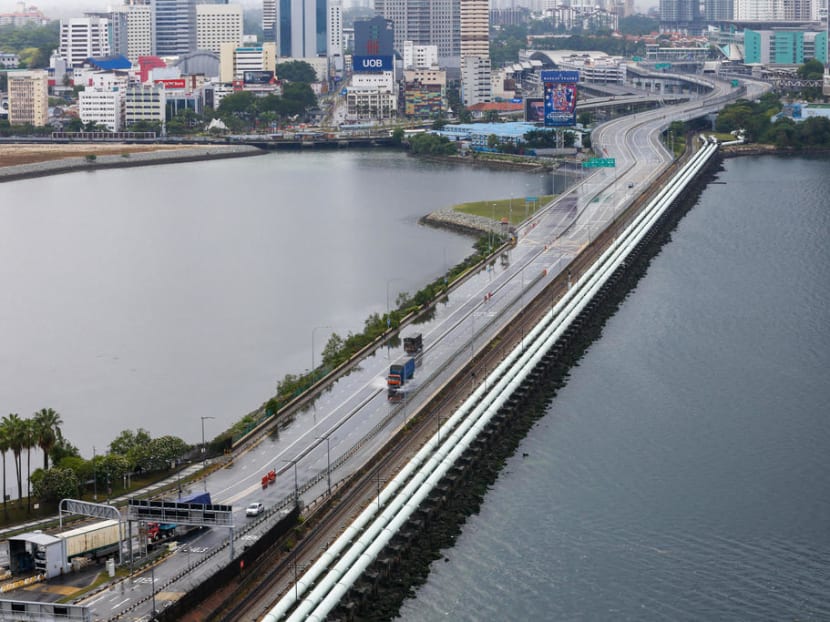Singapore-Malaysia land VTL may involve rail next, but car trips won’t happen so soon: Gan Kim Yong
SINGAPORE — The vaccinated travel lane (VTL) between Singapore and Malaysia could be extended to train crossings next, but it may take a longer time before travellers are allowed to cross the Causeway in cars or other forms of private transport.

Before the Covid-19 pandemic, more than 300,000 people used to cross the Causeway (pictured) daily, making it once one of the world’s busiest land border crossings.
- Singapore is exploring allowing train journeys under the recently announced land border vaccinated travel lane
- Officials from both countries will review the capacity weekly, based on the public health situation
- Trade and Industry Minister Gan Kim Yong said it is unlikely for traffic on the Causeway to return to pre-pandemic levels
SINGAPORE — The vaccinated travel lane (VTL) between Singapore and Malaysia could be extended to train crossings next, but it may take a longer time before travellers are allowed to cross the Causeway in cars or other forms of private transport.
It may also take some time before land traffic between the two countries returns to pre-pandemic levels, Trade and Industry Minister Gan Kim Yong said.
He made these comments at a news conference on Wednesday (Nov 24) evening, hours after the Singapore and Malaysian governments announced that a controlled number of vaccinated travellers may cross borders via the Causeway from next Monday.
In the first phase, there will be a daily quota of about 1,500 travellers entering each country via 64 designated bus trips each day, without the need to serve quarantine.
“We are starting with the buses because, as you can imagine, it is easier to manage, the capacity is more manageable and there's a booking system,” Mr Gan said. He who had just come out of a video conference with Senior Minister Azmin Ali, his Malaysian counterpart.
“Therefore, we can actually decide how many people will be allowed to go across, based on the number of bus trips that will be going across.”
Mr Gan also said that it may take a longer time before travellers are allowed to cross the Causeway in cars or other forms of private transport because unlike trains or buses, they do not have a fixed capacity.
“And if we were to do that, there would also be some form of a booking system or registration system so we know how many people are going across every day,” he added.
“So the immediate focus is really on buses and the next step may be on the train between the two places.”
Singapore and Malaysia are also linked via a train route between Woodlands and Johor Baru run by Malaysian rail operator KTMB.
Officials from both sides are hoping to increase the capacity for bus trips on a weekly basis, but that will have to depend on the Covid-19 situation remaining stable in the two countries, Mr Gan said.
“We also discussed that it is probably not possible for us to revert to the pre-pandemic situation where we have, maybe, more than 100,000 people travel across the Causeway every day.”
He added that officials will gradually open up this scheme to allow general travel so that more people can make trips.
Under this arrangement that will start next Monday, travellers must be citizens, permanent residents or long-term pass holders of the country that they are entering.
Before the pandemic, more than 300,000 people used to cross the Causeway daily, making it once one of the world’s busiest land border crossings.
MAY MERGE TRAVEL ARRANGEMENTS IN FUTURE
Right now, workers can travel between Singapore and Malaysia via the Periodic Commuting Arrangement.
Under this route, travellers entering Singapore must spend at least 90 days here for work before being eligible to return to Malaysia. They will also be subject to a seven-day stay-home notice.
There is no requirement for the travellers to be fully vaccinated to travel via this route, unlike the travel lane scheme.
The Periodic Commuting Arrangement will remain for now, Mr Gan said, but he added that the Singapore Government may merge the two travel arrangements to make it more convenient for workers once the process for the travel lane scheme stabilises.
He added that the existing arrangement for cargo drivers entering Singapore will remain the same. Cargo drivers entering SIngapore from Malaysia via the Tuas and Woodlands checkpoints are required to either take an antigen rapid test or show proof of vaccination.
Mr Gan said that Singapore’s authorities are expecting travel demand to increase during the Chinese New Year celebrations in February next year, when families traditionally hold reunion dinners.
He reiterated that the capacity for the travel lane will be increased progressively, taking into account the public health situation in both countries.
“Bearing in mind that as we expand the VTLs, we do expect to see (Covid-19) cases that will come through,” Mr Gan said.
However, since travellers must be fully vaccinated, the Government expects those cases to have limited impact on the healthcare facilities.
“So my message is that I will urge Singaporeans to be patient. I know many Singaporeans really want to visit your family members, your loved ones or your friends over in Malaysia,” he said.
“We need to do this progressively and in a safe manner.”








